Overall, I think my animation is not very successful. It did not turn out the way I wanted it to be. I encountered a few problems that I cannot solve. I wanted my second box to fall right into place but the parent constraints had some problems and I cannot make it drop on to the platform for some reason. I used the following principles of animaton:
1)Exaggeration- When he is shaking in all kinds of directions to get the box that was stuck off.
2)Timing-The shaking started fast at first and guadually got slower when Sam got tired.
3)Arcs-The turning actions that Sam made when placing the boxes.
4)Straight ahead action and pose to pose- The shaking starts slow at first before and changes speed in the middle, Sam also changes his pose from turning left to the right rapidly.
Saturday, August 20, 2011
Friday, August 19, 2011
Storyboard & Character
Storyboard
Character of Sam 'The hardworking robot'
Sam is very serious in getting his work(which is transporting boxes) done before he leaves for home. He always finishes his workload way before the deadline. He is well-liked by everyone and is often complimented by his boss for being competent in his work.
(scenario 5)
The name of my robot is Sam.
*Sam's thoughts while lifting boxes*
Yes, 1 hour till work ends. I have got only a few more boxes to move. I'm so tired. I can't wait to get home and rest! *Box gets stuck* What happened?! Why can't I get this box off me?! This is so irritating! Oh, wait! I got an idea! Maybe if I keep slamming the box. The box might just dropped out on its own! Alright, I think it might work!
Sam is working by himself.
Sam's job is to move the boxes from one side to the other.
He tried to put down the box he is moving but he realised the box is stucked and he cannot let go of the box.
He started turning left and right to try to shake off the box that was stuck in his arm.
He also tried to shake up and down too.
He then tried to slam it on the the other boxes.
The box is finally shaken off and moved to the right area with other boxes.
Character of Sam 'The hardworking robot'
Sam is very serious in getting his work(which is transporting boxes) done before he leaves for home. He always finishes his workload way before the deadline. He is well-liked by everyone and is often complimented by his boss for being competent in his work.
(scenario 5)
The name of my robot is Sam.
*Sam's thoughts while lifting boxes*
Yes, 1 hour till work ends. I have got only a few more boxes to move. I'm so tired. I can't wait to get home and rest! *Box gets stuck* What happened?! Why can't I get this box off me?! This is so irritating! Oh, wait! I got an idea! Maybe if I keep slamming the box. The box might just dropped out on its own! Alright, I think it might work!
Monday, August 15, 2011
Rigging
1) Apart from their different sizes, it is obvious from Luxo Jr. that the big lamp is “older” and that the small lamp is “younger”. How is this communicated by the animation? Give at least THREE examples.
Do NOT say because the small lamp is playing with a ball, or that its name is Luxo Jr. – you should be looking at the animation, how the lamps move and emote (emote means to express emotions).
The big lamp has a duller color and the light it has is dimmer in comparison to the small lamp. The big lamp's movement are slower than the small lamp. The big lamp keeps looking at whenever the small lamp go and shakes its head when he sees that the small lamp is so energetic. The big lamp has a more 'adult-like' response towards the ball.2) Give an example from Luxo Jr of how timing is used for comic effect. Explain how the timing decision contribute to the humour.
I find it rather timely when Luxor Jr went out of the video screen to get a even bigger ball even though he just flattened the small one. It made me laughed a little. It surprised the viewers at first because we did not expect what happens next.3) When you create a joint chain, these form a hierarchy, with the first joint at the top and the last joint at the bottom. Explain why this is necessary for the joints to work properly.
This is because in hierarchy the ones at the top controls the ones at the bottom. If the one at the top moves to the right, the ones that is jointed at the bottom follows through. On the other hand, if you move the last joint at the bottom., the ones above will not follow.
Sunday, August 14, 2011
Maya bouncing ball tutorial videos reflection questions
After watching the 2 hour tutorial of bouncing ball. I learnt alot about the basics of using Maya to create animation. For example, I learnt how to apply a bump map, setting up the camera and rotation.
1) Do you need to draw well to create good 2D animation? Explain your view.
Yes, I think you need to draw well in order to create good 2d animation. 2D animation is drawn using hand therefore the artist must be good in drawing. All else nobody would want to watch 2D animations that has poorly drawn characters.
2) Do you need to be able to draw well to create 3D animation? Explain your view.
No. I do not think that you need to draw well to create good 3D animation. Unlike 2D animation, 3D animations are created using softwares like Maya. It is presented using 3D models rather than 2D drawings. I think the 3D animators just need to have a creative imagination.
3) What do you think would separate a piece of animation from a piece of good animation? In other words, how would you go about deciding if a piece of animation is good or bad?
I would decide whether the animation is good or bad by looking at how the characters move. I think the charcters must move in a natural and realistic way, so that it would look convincing to me. The facial movements of the charcters must react accordingly to what is happening in the story. They should also avoid cliched poses and reactions, while still being able think up new ways to surprise the audience.
4) In 2D animation, you need to be aware of timing at a frame by frame level, using timing charts and other techniques- but for 3d animation, this is handled using graph editor, which is more concerned with manipulating rates of change over time. Does this affect how you approach your animation work? Explain.
Yes, it does affect how I approach my work. I think 3D animation suits me better as using a graph editor is more efficient for me rather than having to draw the animation out.
5)Give a brief critique of Maya as an animation tool. Don't just say Maya makes animation difficult , or easy, or that you need to learn a lot of stuff to use Maya- explain what Maya does well and not so well in terms of creating animation.
I think Maya is quite well rounded in creating animation. I did not encounter major problems in using the software. Maya makes the 3D animation rather realistis and smooth in my opinion. I cannot give much critiques about it as this is the only 3D software I have ever used to create animation. Overall, it is very easy to use and I do not have any problems with it. It is a great animation tool.
1) Do you need to draw well to create good 2D animation? Explain your view.
Yes, I think you need to draw well in order to create good 2d animation. 2D animation is drawn using hand therefore the artist must be good in drawing. All else nobody would want to watch 2D animations that has poorly drawn characters.
2) Do you need to be able to draw well to create 3D animation? Explain your view.
No. I do not think that you need to draw well to create good 3D animation. Unlike 2D animation, 3D animations are created using softwares like Maya. It is presented using 3D models rather than 2D drawings. I think the 3D animators just need to have a creative imagination.
3) What do you think would separate a piece of animation from a piece of good animation? In other words, how would you go about deciding if a piece of animation is good or bad?
I would decide whether the animation is good or bad by looking at how the characters move. I think the charcters must move in a natural and realistic way, so that it would look convincing to me. The facial movements of the charcters must react accordingly to what is happening in the story. They should also avoid cliched poses and reactions, while still being able think up new ways to surprise the audience.
4) In 2D animation, you need to be aware of timing at a frame by frame level, using timing charts and other techniques- but for 3d animation, this is handled using graph editor, which is more concerned with manipulating rates of change over time. Does this affect how you approach your animation work? Explain.
Yes, it does affect how I approach my work. I think 3D animation suits me better as using a graph editor is more efficient for me rather than having to draw the animation out.
5)Give a brief critique of Maya as an animation tool. Don't just say Maya makes animation difficult , or easy, or that you need to learn a lot of stuff to use Maya- explain what Maya does well and not so well in terms of creating animation.
I think Maya is quite well rounded in creating animation. I did not encounter major problems in using the software. Maya makes the 3D animation rather realistis and smooth in my opinion. I cannot give much critiques about it as this is the only 3D software I have ever used to create animation. Overall, it is very easy to use and I do not have any problems with it. It is a great animation tool.
Tuesday, August 2, 2011
Squash And Stretch Bouncing Ball In Maya
This is the bouncing ball that is created with squash and stretch. I learn how to use a deformer to create a "squash effect" on the ball bouncing across the screen.
1) Why is squash and stretch so useful in animation?
I think it helps to give more life to the ball. The ball changes shape whenever it hits the ground. It is like a reaction from it. It is also more interesting to watch too.
2) Think of a situation in which extreme squash and stretch could be applied to a character - try to be original.
A baby is pinching/pulling her sister's cheek while she is carrying him.
3) Think of an animation example where squash and stretch would NOT be appropriate.
A person playing baseball. The ball is hard and cannot be squashed and stretched.
4) If squash and stretch doesn't really happen so obviously in real life, why do you think is it so effective in animation?
(Look at the title of Disney animator Ollie Johnston's famous book about animation - do an Amazon search ... there's a clue in the title!)
(Look at the title of Disney animator Ollie Johnston's famous book about animation - do an Amazon search ... there's a clue in the title!)
I think it's effective in animation because it makes the animation more exaggerated.
Tuesday, July 12, 2011
Bouncing ball (Maya)
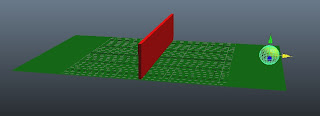
I learnt how to set key frames and make a bouncing ball animation in Maya. I learnt how to edit the curves using the graph editor. I think this exercise helps me understand better on animation.
Friday, July 8, 2011
Bouncing Ball animation in Pencil
Bouncing ball animation that is created using Pencil
Friday, July 1, 2011
12 principles of animation
Exercise 2
Anticipation
The girl on the left is anticipating for the girl on the right to throw the thing to her.
Slow in and slow out
Squash and stretch
Follow through and overlapping action
As they do the chicken dance, each part of their body moves at a different pace.
Straight ahead action and pose to pose
The girl's size becomes bigger and bigger as she runs to the camera.
Exercise 3
Follow this link to see these 6 different principles of animation - Anticipation, Arcs, Follow through and overlapping actions, Squash and stretch, Secondary action and Exaggeration
=> www.youtube.com/watch?v=46hBd18ZYMo&feature=related
Explanations
1)Anticipation- The guy in the video is getting ready to jump over a distance. The viewer will not know how far he can jump.
2)Arcs- The guy in the video is moving his arms by rotating his joints to throw a ball forward. Arcs are natural actions/movement.
3)Follow through and overlapping actions- His arms and legs are moving at different speeds and anglea all at the same time. His arms and legs are still moving when he stops moving and stays in place.
4)Squash and stretch- His muscles are changing shape and also returning to original shape as he tries to pick up the dumbell.
5)Secondary action- His head is moving upward while his hands are pulling the dumbell up.
6)Exaggeration- The dumbell was bent out of shape in the end which is quite exaggerated.
Anticipation
The girl on the left is anticipating for the girl on the right to throw the thing to her.
Slow in and slow out
The girl moves from squating down to standing between two extreme position.
Squash and stretch
The wallet changes shapes as it hits the wall and touches the ground.
Follow through and overlapping action
As they do the chicken dance, each part of their body moves at a different pace.
Straight ahead action and pose to pose
The girl's size becomes bigger and bigger as she runs to the camera.
Exercise 3
Follow this link to see these 6 different principles of animation - Anticipation, Arcs, Follow through and overlapping actions, Squash and stretch, Secondary action and Exaggeration
=> www.youtube.com/watch?v=46hBd18ZYMo&feature=related
Explanations
1)Anticipation- The guy in the video is getting ready to jump over a distance. The viewer will not know how far he can jump.
2)Arcs- The guy in the video is moving his arms by rotating his joints to throw a ball forward. Arcs are natural actions/movement.
3)Follow through and overlapping actions- His arms and legs are moving at different speeds and anglea all at the same time. His arms and legs are still moving when he stops moving and stays in place.
4)Squash and stretch- His muscles are changing shape and also returning to original shape as he tries to pick up the dumbell.
5)Secondary action- His head is moving upward while his hands are pulling the dumbell up.
6)Exaggeration- The dumbell was bent out of shape in the end which is quite exaggerated.
Friday, June 10, 2011
Self Critique of Project 1




I think my final model was quite successful because it matches closely to the original object and my intial conception. I'm very pleased with the body of the toy cow as I think it is the best modelled. I am very happy with the overall outcome. I think the head of the model needs some improvement as it needs to look more smoother like the real toy cow. The tail of the real tail is a little curled upwards but my model's tail is modified slightly curling down.
Research of project 1

I researched on how to model a head of a cow by using a tutorial based on 'Maya At A Glance'. The shape of the head is entirely different but I still used it as reference. I find it was rather helpful in teaching me where to start from. First, I created a polygon cube. I used smooth tool to smoothen out the sharp edges of the polygon cube. I also extrude, pull and scale so as to create ears for my toy cow. I used the sculpt geometry tool to smooth the vertex position of the model. I also learnt how to make the cow head symmetrical by deleting one side of the model by using the mirror geometry tool in the Polygons menu. It saves time and effort too. Those were similar steps that I think could be implemented in my cow toy model.
Thursday, June 9, 2011
Tuesday, June 7, 2011
Story and shape of project 1
Story
I decided to model a toy cow for my project 1. The story is about a rat racing around a track on a mousetrap car. The toy cow is lying in the middle of the track and the mousetrap car is heading towards it in blazing speed. The rat who is trapped in the car, struggled frantically after realising he is heading straight towards the toy cow. To no avail, his constant struggles was useless, he eventually crashed into the toy cow. The car bounced off the track and fell on to the ground. Due to the impact, he broke free of the grasp of the mouse trap. He scurried back to his mousehole before anyone notices.
Shape
The toy cow consist of its head, body and tail. The toy cow does not have any eyes but it has a nose and ears at the top of its head. Its surface is rather smooth. Extrusion, bevelling and Cv curve tool and moving the vertices can be used for creating the model. I find the head a bit difficult to model but I will try my best.
Sunday, June 5, 2011
Wooden block materials
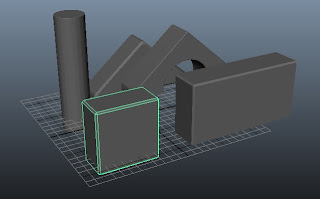
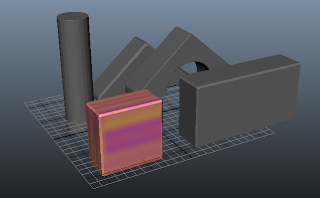
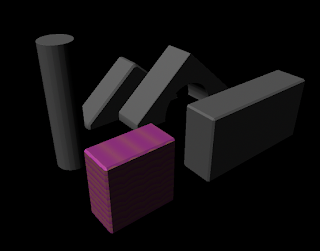
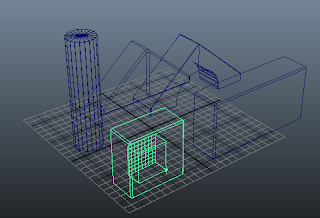

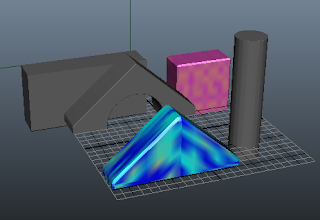
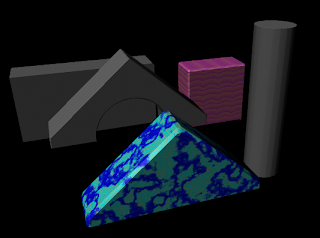
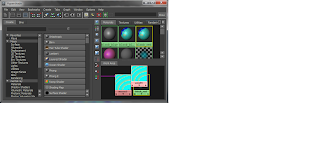
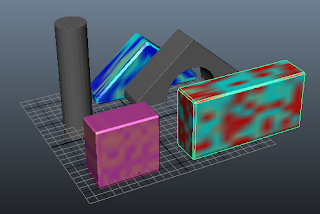
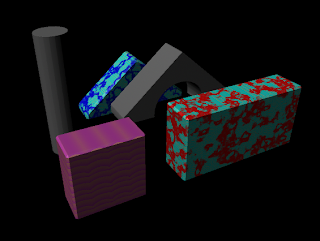


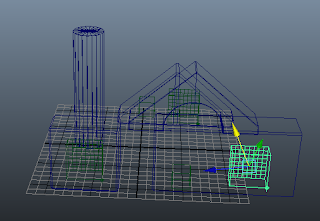
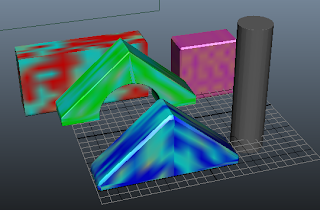
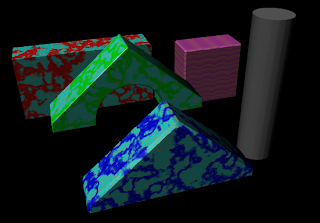
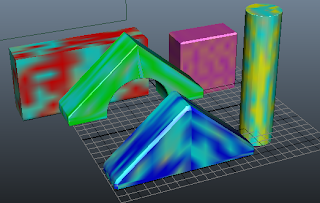
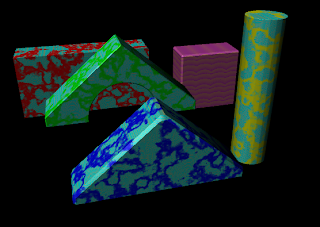
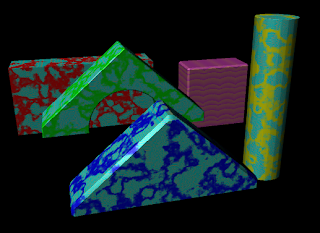
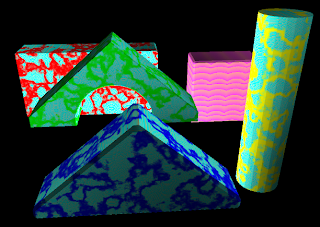
For this exercise I learnt how to apply new materials to the block object. I learnt that we can change the texture and color of the materials. I must link the node to the block so that grain stays with it in the current orientation when the block is moved. I also learnt how to use hypershade to create and edit connect nodes, textures, lights, rendering abilities and special effects. For example, duplicating the material of a block and changing its color and lastly, relink the right nodes to the right object. I also learnt how to change the settings of the render by using the Display Render Settings. I also learnt how to put a light on the scene, in order to brighten up when you are rendering.
Subscribe to:
Comments (Atom)












 Backview
Backview












